Rear View Mirror & Case History,
Volume 9, No.3
Author
- Don Capps
Date
- December 13, 2011
Download
- RVM Vol 9, No 3 (PDF format, 1.6MB)
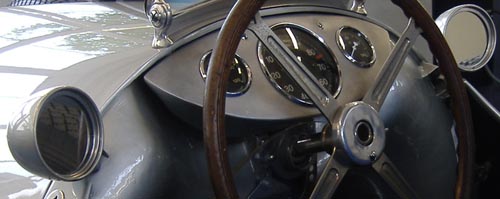
Chasing Down the Dust Bunnies of Automobile Racing History – non semper ea sunt quae videntur – Phaedrus
“Pity the poor Historian!” – Denis Jenkinson | Research is endlessly seductive, writing is hard work. – Barbara Tuchman
October fests
The Society of Automotive Historians (SAH) held its annual meeting and awards banquet at the Hershey Country Club in Hershey, Pennsylvania, on 7 October 2011, a very pleasant, almost summery Friday evening. On the following day, 8 October 2011, the International Motor Racing Research Center (IMRRC), located in Watkins Glen, New York, to celebrate the fiftieth anniversary of the first United States Grand Prix run there in 1961 – held coincidentally on that very date.


The annual SAH meeting in Hershey is where the awards are announced, of course, with two of the awards being of some interest to those with an interest in the world of automobile racing. The E.P. Ingersoll Award is given for “excellence in presentation of automotive history in other than print media.” It is named after the first editor of The Horseless Age, the pioneering automotive journal. The award was given to Jim O’Keefe for the O’Keefe Winners Database: A Searchable Comprehensive Digital Database of Motor Racing Events. This the database on a disc that Dr. Joe Freeman’s Racemaker Press released following the publication of The Winners Book: A Comprehensive Listing of Motor Racing Events 1895 – 2009, which was reviewed in an earlier number of RVM. I thought that it was interesting choice and one that would probably have been on list of possible candidates.
Racemaker Press was also the publisher of the Nicolas-Joseph Cugnot Award, English Language, whose criteria simple: the book “which represents the most outstanding writing and original research in automotive history.” The recipient of this award for 2011 was Caribbean Capers: The Cuban Grand Prix Races of 1957, 1958, and 1960, by Joel Finn.
Finn covers the three events in 360 pages of text and photographs, easily making the word “definitive” seem almost inadequate to describe its contents. In his remarks when accepting the award, Finn mentioned that given that both factions in the Cuban community seemed somewhat peeved with the final result, he must have done something right. The book is not cheap at $200 nor is it on a topic that would usually have much of an audience. That said, it is the usual sort of work that one expects from Finn: lots and lots of readable text, good research, and the use of photographs as other than “eye candy.” I managed to slowly skim through the book – an advantage of arriving early – and almost blew my allowance on a copy.


My dinner companions that evening were Joel Finn and his wife, Joe Freeman, and Gordon White and his wife. Needless to say, it was a very enjoyable time, Gordon and I having much to talk about given some of our shared interests. I must add that the program for the evening was a pleasant surprise. Generally, I am not much of a fan of “one-man shows” on historical figures, the presentation, Bandits, Guns and Automobiles: New York to Paris Race 1908, by Jeff Mahl was exceptionally well done. The grandson of George Schuster, the head mechanician and leader of the Thomas team for the 1908 event, Mahl did an exceptional job. Using contemporary photographs and both the stories heard during childhood from his grandfather as well as family records, it was both an entertaining and informative presentation. I am a bit chagrined to admit that it crossed my mind to “beat feet” after the dinner, but circumstances led to my staying and I did not regret it.
On Saturday, I drove from Harrisburg to Watkins Glen, covering almost exactly the same route I had traveled a half century earlier, the difference being that US 15 bears little resemblance to what it did then. It is no exaggeration to state that it was a true journey and a grand adventure to make the trek from Columbia, South Carolina to Watkins Glen and return in those days. I honestly had not a clue as to where Watkins Glen actually was in those days. All I had was some vague notion that it was somewhat to west of New York City – which was all the New York I knew about back then. That there was a State of New York that was out there was a bit difficult to grasp at first.
Just as it had been in 1961, the weather for the weekend was wonderful. The IMRRC was commemorating the occasion with two presentations. The first was a talk by Dr. Michael Lynch on his friend Phil Hill and the second as a talk on his friend Mario Andretti by Gordon Kirby. Both presentations were top notch, of course, Lynch and Kirby being the seasoned professionals that they are. I will admit that having grown up as an American in Europe, that Phil Hill has always been, for lack of a better word, “special” to me. Perhaps, some of that was the usual schoolboy hero worshipping, part of it being his being an American competing on foreign soil, and part of it being that in my few interactions with him I sensed something about Hill being other than simply a racing driver. I do know that I have always considered him to be very underappreciated, both then and later. It was nice to hear Lynch bring the complexity of Hill to the fore, to allow one to appreciate Hill as someone whose life was far more than that of racing automobiles.
The Mario Andretti that Kirby spoke about was so very different than the Phil Hill presented by Lynch, but only at first glance. Andretti came along at a point when racing was changing and managed to not only be a top notch racer as a new face on the scene, but was still competitive when he finally retired from being a regular on the CART circuits. It was a story well-told and about a fascinating character. Once again, I must admit to having a “soft spot” for a driver, Andretti being one of those I liked almost literally from the beginning, being impressed by his versatility and talent, being able to adapt to whatever he drove and go fast.
These scant lines simply cannot even begin to do the presentations given by Lynch and Kirby justice. Both were articulate and eloquent in their presentations on the American world champions. This is very much the standard for the many “conversations” that the Center holds over the course of a year. My regret is that I simply cannot attend as many as I would wish to attend.
A surprise guest at the Center’s get-together was Bill Sadler, the innovative and creative Canadian constructor whose time on the racing scene was surprisingly brief but impressive.
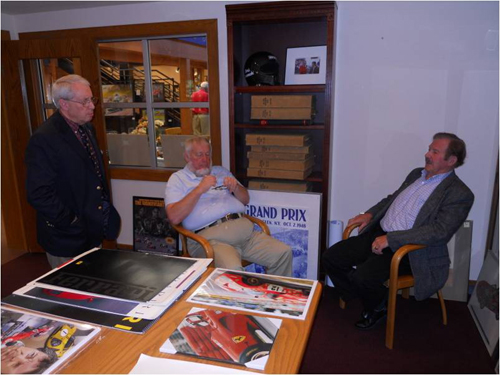
From right to left: Bill Sadler, Bill Green, Don Capps (photo Brian Brown, used with permission)
Here, courtesy a photograph by Brian Brown, is Sadler, on the right, talking with the Center’s historian, Bill Green, and myself about his time in the racing game. We are in the Reading Room of the Center, where most of the archival holdings and rare books are kept. Sadler also spoke that afternoon prior to the talks given by Michael Lynch and Gordon Kirby. The good news is that Sadler is in the midst of writing a book on his cars, something long overdue. Sadler is almost a Renaissance Man, his career after racing being perhaps even more interesting than the one he had on the track, unusual for those who leave the sport while still in their Twenties as Sadler did. Needless to say, it was a delight to spend time with Sadler, discussing not only racing, but our shared interest in aviation and what could be quaintly referred to as “advanced defense technologies.”

Mike Argetsinger (photo Brian Brown, used with permission)
Thanks once again to Brian Brown, here is a photograph of Michael Argetsinger signing a copy of his latest book, Formula One at Watkins Glen: 20 Years Of The United States Grand Prix, 1961-1980.
Dust Bunnies & Automotive Competition History
Random Thoughts & Other Observations
Chasing down the dust bunnies of automobile racing history is, in so many ways, easier than it may have been just a few years ago, to say nothing of several decades ago. Then again, the problem of the tree falling in the forest with no one around to hear it still applies. While we might have greater access to and, as a result, an abundance (if not a surplus) of information thanks to the Internet and the World Wide Web, we still seem to have something of a knowledge gap.
Articulating that knowledge gap is, naturally, not as easy as stating the blindingly obvious, something that is evident to even The Untrained Eye. One could argue that being information rich and knowledge poor is far preferable to being poor in both, and there is a large grain of truth in that statement, of course. Rather, it would seem that most have settled for the notion that reading and participating in various fora discussing automobile racing nostalgia is a substitute for, well, something that would resemble research. In too many cases, much time and effort is devoted to trivia and the trivial, although that is dwarfed by that devoted to chitchat devoted to nostalgia and endless expressions of opinion.
After much consideration and more than a bit of thought, I have decided to pretty much abandon the Internet forum and devote my efforts elsewhere. I do so with a sense of resignation given that I once thought that this approach, a literal forum for discussion and (hopefully) collaboration, could and would pave the way for not only more work in the research arena, but the development of a greater interest in the application of the tools and the thinking employed by historians to the sport, moving the discussion along from the usual nostalgic musings and the obsessive attention given to the machinery to the detriment of the other aspects involved with racing that were generally being ignored.
It was, frankly, a naïve notion, one which did not adequately reckon with the brutal fact that the vast majority of those who frequent such fora have little to no interest in scholarly discussion or for observations crouched in academic argot. As is usually the case, one can manage to put together something that works and is successful in the short term, but is doomed to failure in the long term. Needless to say, few owning such fora have any doubt as to the path to popularity and success for a forum, a path that does not run through the realm of Clio.
While there certainly was what could be termed the halcyon days of The Nostalgia Forum on what was then part of the Atlas F1 Bulletin Board and is now part of Haymarket and its autosport.com site, they appear to long gone and the rays of sunshine few and far in-between. While one is hopeful that the recent creation of a sub-forum devoted to historical research might turn the tide, one also would be warranted in thinking that it might be too little and far too late. Oh, TNF will probably lumber and stumble into the future, surviving for years to come, but it is largely an intellectual desert with fewer and fewer oases as the years move along.
Of course, the same observations regarding TNF are those that can be applied to the other bulletin boards with a forum devoted to either nostalgia or history – only most never experienced the level of scholarly work and thinking that emerged, even if only in passing, on TNF. I am always both amused and somewhat annoyed that there is a group on Yahoo Sports, “Racing History,” that is in reality rather dead set against actual historians, several of us departing due to that small problem.
While there has been, is, and can be much good that can result from the various Internet for a such as TNF, it is more akin to the tiresome process of panning for gold in the Yukon: lots and lots of time and effort expended with usually very little to show for it. Plus, one need not be a regular or a member of a forum to make the occasional visit to a forum to skim over what has been posted searching for something that could of interest and even useful.
While there certainly might be some utility in a forum such as TNF or similar fora, unless properly moderated and guided, they tend to be simply places where people gather to socialize and reminisce, wax nostalgic, and usually do so under the cloak of anonymity that comes with the use of, well, “user names,” which more often than reflect the mischievous imagination of teenagers than those inclined to engage in serious, academic-like discussion. This cloaking also allows the general use of ad hominem attacks as well as a means to display the all too usual prejudice against things intellectual. For any number of reasons, these fora seem to bring forth the lesser angels in all of us.
While I have not been all that kind to journalists when it comes to automotive history, it is becoming clear that there certainly are many cases where it is far easier for the journalist to make the transition to historian than for the historian to somehow become capable of the level of writing that makes, to use a cliché that really is not, “history come alive.” Therefore, one should remember to consider the result, not necessarily the one responsible for the result.
To circle back a tad to information and dust bunnies, the Internet and the Web have allowed scholars to have access to information on even as obscure a topic as automotive competition at a level that few imagined possible several decades ago. The long and much-discussed Digital Library is finally beginning to become a reality for researchers. The controversial and troubled project by Google to digitize the contents of several research libraries and then use them as the basis for its notion of a Digital Library has run in serious difficulties, most of them it must be said being self-inflected.
For the automotive historian, however, there is some reason to rejoice, whatever one may think about the approach that Google may have taken in executing their project. Thanks to the Google effort, dozens and dozens of automotive journals from a century or more ago are now available in digital form. They can be downloaded and added to one’s own personal digital research library. While there are many gaps in the volumes of the journals that have been available, that there are even any available is a cause for giving thanks.
While the tangled and complex issues regarding the various lawsuits and so forth concerning the Google effort give little hope for any resolution to be achieved soon, there are other efforts regarding the digitization of research materials that need to be mentioned. Perhaps foremost among these is that of the folks at Motor Sport. The digitization effort of the new publishers of Motor Sport is little short of remarkable: each issue from 1924 to 1999 is available on a series of six discs from the magazine itself. While certainly not dirt cheap (about $80 each), the discs are inexpensive enough for the serious researcher to be able to afford to make the investment. While the discs will never replace the magazines themselves, at least not in my personal opinion, it would be difficult to imagine any other way to gain such easy access to this material.
While the Google project managed to make a large number of mostly American automotive journals available from the early Twentieth Century as a result of the digitization process, there is another source for this material, one that still has gaps in its collection, but one that should be given the wholehearted support of scholars conducting research for topics during this period. The Horseless Carriage Foundation, Inc., of La Mesa, California, has digitized much of its collection of automotive journals and made them available through its digital research library.
There is a fee for the use of the digital research library – one can either join the HCFI for an annual fee and access or use a plan for accessing the material by paying a fee for a level of access. Unlike the Google-digitized journals, the HCFI does not allow downloading an entire journal: one accesses the material a page – a look or view – at a time. The material is in the form of Adobe Acrobat PDF files which can be downloaded.
While I find the search engine for the HCFI material more than a bit clunky and not always able to find the material being requested, this is offset in many cases by the fact that the copies of the material found in the HCFI collection tend to be better than the Google-generated copies in many cases; regarding the latter, it not uncommon for the pages to be blurred, distorted or completely unreadable at times, which can be extremely frustrating. With very few exceptions, the pages found in the HCFI material are clear and useable. The fees associated with the HCFI are more than reasonable and very affordable – certainly much cheaper than attempting to arrange the transportation, lodging, and access to those few libraries or collections with this material.
It should be noted that the material that Google generated before the effort was halted, due the various legal issues as mentioned, can be found at a site operated by the University of Michigan: the Hathi Trust Digital Library. Find the material can be a bit of a challenge, just as can accessing and using the material can be. Apparently, the bandwidth is of soda straw dimensions because one will find one’s research session being placed into limbo due to “exceeding one’s bandwidth” or other such message, the presence of many users reducing the pace to a slow, hard slog at times as one gets “timed-out” time and again. However, it is far better than the alternative: nothing. As in the case of HCFI, the material is in the PDF format and can be downloaded; if one is a member of the community that allows access to the University of Michigan library system, one may download an entire journal, otherwise it is a page at a time.
In addition to all these efforts, other efforts have provided access to materials that would not be easy to have at one’s disposal. Some years ago, the late Bob Norton scanned a number of automotive serials and made them available, the first being the entire run of the tabloid editions of MotoRacing, the West Coast sports car publication that few now remember and fewer have even a few copies of after all these years. Early issues of Competition Press were another of the publications that Norton made available online, the 1951 and 1952 editions of the long-forgotten Motor Sports World being another. Recently, issues of Sports Car, the publication of the Sports Car Club of America, covering the years from 1944 to 1970 were digitized and made available – for a fee – to those interested in adding such material to their research library.
While the digitization of more and more research material and resources relating to the history of automotive competition continues, it is a blinding flash of the obvious to state that much remains to be done. To produce a digital page carries, the process itself requiring an investment in both time (labor) and equipment. Even with a volunteer force providing the labor at little or no cost, the scanning equipment and other aspects of production do require an outlay of capital whether the product is placed on the Internet or some form of media storage. Hence, one readily anticipates that the entrepreneurial model will be the means by which much of the material will be made available to researchers. Likewise, with the increasing popularity of electronic books (eBooks), one can anticipate this format to be utilized for materials such as books regarding niche markets such as automotive competition.
Whither, then, the future of brick and mortar? While it might be a majority view to think that the death of brick and mortar is somehow imminent, that might be somewhat more accurate to suggest that while research will leans towards and be more and more facilitated by digital materials – a process already well underway, there will continue to be a physical presence of libraries, research centers, and other research facilities for years to come. The printed word, whether in the form of a book or serial, might be heading towards the endangered list, but has a long way to go before that happens. This is, in large part at least, due to the costs involved making the transition from one medium to another.
It should be noted that for all the discussion of printed and digital media, that microfilm (and microfiche) still survives as a storage medium. Just as books and other printed matter can survive for years and years – many decades, the durability of microfilm is a factor often overlooked. There are basically two formats for microfilm, 16mm and 35mm, with virtually every microfilm reader available fully capable of accommodating either format.
On the other hand, Moore’s Law shows little inclination to slow down, computing power – and applications, continuing to move forward at a brisk pace. That has led to headaches for many, the obsolescence of software being the primary one. If one finds a cache of digital information that was generated in, say, WordPerfect 5.1, which was designed for the pre-Windows DOS systems, it can be difficult to retrieve it. Not impossible, but difficult enough. Even when retrieved, printing the material in its original format can be a challenge. That there seems to be an acceptance of the Portable Document Format (PDF), courtesy of Adobe Acrobat, as the de facto digital format, may avoid many such problems in the future. This one reason that each issue of Rear View Mirror is also offered in that format.
There remains, as ever, the problem that is independent of the advances in information technology: the writing and dissemination of the history of automotive competition. Getting something literally into print has always been something of a challenge, whether an article for a serial or a book, whether one might be a journalist or a historian. Some manage by their writing and research skills and luck – in that order I would suggest, to have their work appear in print, often time and again. The advent of the Internet as a means for supplementing the printed word created other means for some to see their words circulated to others. As newsletters, club bulletins, and other similar publications began to fall victim to postage and publication-related expenses, editors and staff departed, and people shifted to using the Internet as an important source for the acquisition of information, it opened up other avenues for writers and historians.
Rear View Mirror began in April 1999 as a column for the Atlas F1 Journal; the Journal appeared each Wednesday and the RVM column generally every other issue. The Atlas F1 Journal was, in essence, a virtual second cousin of The Alternate, a twice-monthly serial that covered automobile racing history. While the Journal and The Alternate were certainly a case of Yin and Yang, the driving force behind both was similar: to produce a written work for others to read. Both are now gone, The Alternate due to the death of Phyllis Devine, its editor and publisher, while the Journal due to the departure of its originator, Paul Kaizer, and co-owner and editor, Bira Goren, after the purchase by Haymarket along with the constant-news-cycle approach of the new owners. Both, however, opened the door for new participants in the discussion of issues related to automotive competition, each in its own way.
The number of automotive historians focusing on automotive competition has never been great, but scarcely outnumbered to any large extent by those from the field of journalism writing about the topic. In an earlier statement, I ventured the opinion that it was probably easier for a journalist to become a historian than the other way around. Indeed, there are cases where the transition has certainly taken place, with the results to suggest such an idea. This is being mentioned in the context of a concern as to the future, especially in light of the fact that many of the current practitioners – yours truly included – have reached a “certain age,” vaguely defined as numerous decades, or will do so soon.
Both the journalism and the history professions have changed in the past several decades, often in significant, even profound, ways. Some of this is undoubtedly due to the revolution in information technology, part, perhaps, attributable to the evolution and morphing that is part and parcel of any profession. As journalism has become more attuned to its virtual presence, with newsrooms and related operations being “downsized” by newspapers and magazines large and small, the journalism as depicted by The Front Page or Ed Asner as “Lou Grant” now belongs to the ages. The profession survives, but with the adjective “freelance” being used as an antecedent to the word “journalist.”
With fewer and fewer positions on college faculties being filled by tenured professors, fewer pursuing advanced degrees in history, and history being consigned to the “social studies” graveyard at the primary and secondary education level, the history profession somehow manages to limp on, battered and bruised, but still on its feet. “Popular History,” as defined in various ways by various people, continues to edge “traditional history” towards the margins, the “wiki” approach now replacing that of the old-fashioned reviewing the literature and then conducting research to come to some sort of interpretation that is as objective as possible. The latter does connote the necessity of the use of one’s own memory to hold, shuffle, and discern the relevance of information as that information then becomes incorporated into what is known as “knowledge,” that is, one’s comprehension, understanding, and familiarity with the information itself, its origins, and how it can be integrated into the context of the issue or topic being mulled over.
The ranks of historians now known formally as being an “Independent Researcher” have increased over the years. Although I notice that there is not an expiration date on my membership card for the Faculty Club at The Citadel, where I was once an assistant professor, which would probably allow me to still dine there, I no longer have any formal association with the faculty. Nor do I continue to hold a position on the faculty of the Model & Simulation University of the Defense Model and Simulation Office of the Department of Defense. Within the Academe, as in the case of many others, I am simply an Independent Researcher. Of course, one advantage of being an Independent Researcher is that one is spared the ennui more often known as the faculty meeting.
Once upon a time, I did not consider my dalliance with the past of automotive competition as “real” history, certainly not in the sense that I understood it, being both a military historian and as one who taught history in the classroom. Being, also, a product of the analyst world – one which has changed dramatically since my undergraduate days, the fusion of the metrics and analyses generated in the cyber world and the worlds of history and research, scholarly and operational, being far beyond what we could have imagined in those years – there has been a inclination on my part to not approach technology as the “spawn of the devil” or as the enemy of the scholar, but, rather as another tool. That said, I do admit to occasional Luddite tendencies when the technology does seem to overwhelm either the process or the means by which information is transferred from one to another. Just what Ned Ludd might have thought of tablet computers and the Internet we can only imagine, but one tends to think that a safe standoff distance would be advised. However, getting back on track, the notion that history is history regardless of its subject matter is one that is difficult to ignore. If one fudges or blurs the line or takes the stance that this is a topic that really is not all that important so it does not really matter, it soon escalates into something akin to an intellectual “domino theory” – one topples and it causes another to topple and so on. At some point, the idea of history gets lost.
While no one wishes for the facts to get in the way of a good story, perhaps it could be suggested the story was not that good in the first place if that is the case. Or, perhaps, too often the stories overshadow the history, which would be another suggestion. Rather one simply wishes for the opportunity to be given the context, the zeitgeist, the life and times, the background against which events – and actors – take place. While this idea is so easy to write, it is quite daunting to execute, as we shall see.
Book Reviews
Sports Journalists Look at Automobile Racing History:
Blood and Smoke, Robert Daley, and The Limit





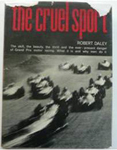

Blood and Smoke: A True Tale of Mystery, Mayhem, and the Birth of the Indy 500, by Charles Leerhsen (Simon & Schuster, 2011, ISBN 978-1-4391-4904-1, $26.00)
The Limit: Life and Death on the 1961 Grand Prix Circuit, by Michael Cannell (Twelve, Hachette Book Group, 2011, ISBN 978-0-446-55472-5, $25.99)
Cars at Speed: Classic Stories from Grand Prix’s Golden Age, Robert Daley (Motorbooks, 2007, ISN 978-0-7603-3117-0, $27.95; originally published by J.B. Lippincott, 1961, paperback by Collier, 1962)
The Cruel Sport: Grand Prix Racing 1959 - 1967, Robert Daley (Motorbooks International, 2005, ISBN 0-7603-2100-0, $50.00; originally published by Prentice-Hall, 1963)
Knowledge breeds doubt, not certainty, and the more we know, the more uncertain we become.1
In Blood and Smoke, sportswriter Charles Leerhsen makes the case for the Lozier driven by Ralph Mulford being the actual winner of the inaugural International 500 Mile Sweepstakes race held at the Indianapolis Motor Speedway on Decoration Day, 30 May, 1911. While playing a bit coy with the reader when making this assertion in the book, Leerhsen puts forward the thesis that the official results are in error while also suggesting that it was probably due as much to “hometown scoring” as, perhaps, honest error resulting from the scoring issues during the race due a problematic scoring system and a wreck that interrupted the official scorers carrying out their duties close to the halfway mark that may – or may not – affected the outcome. This is not a new issue by any means, having been raised by Russ Catlin and Russell Jaslow among others in the past, but it is an unusual and very different approach to take for a book written to commemorate the centennial of the International Sweepstakes race.
As one who rarely hesitates to tackle the conventional wisdom regarding any number of topics relating to automobile racing history, it would be an easy expectation to think that this is exactly the sort of proposal that I could and would endorse and support. While one can certainly lift an eyebrow – or maybe two in a few cases – regarding the official results of the race, I find myself far more in agreement with Donald Davidson, the historian of the Indianapolis Motor Speedway, that the winner was indeed Harroun and his relief driver Patschke rather than Mulford.
In his notes on the sources used in Blood and Smoke, Leerhsen makes the following statement:
No truth was injured intentionally in the creation of this work of nonfiction. No quotes are made up, no scenes manufactured. Conflicting and misleading contemporary accounts are reported as such. The information is drawn from thousands of newspaper articles dating back to the nineteenth century [sic] as well as long since defunct automobile magazines that simultaneously served the fledgling industry and the consumer. I also relied on books, Web sites, miscellaneous material found in libraries, and interviews that I conducted. Rather than use footnotes or ask the reader to flip between the text and a back-of-the-book notes section, I indentify the sources as the information occurs.2
Reading and then re-reading Blood and Smoke, I found myself struck with the thought that it almost seemed as if Leerhsen began the book with the idea firmly in mind that Mulford was the winner and that those thinking it was Harroun were not only wrong, that he would not only prove the case for Mulford, but present a case for it being due to the untoward influence and incompetence of Fisher and others only to find himself faced with not as strong a hand as he anticipated.
The responses by Leerhsen to those challenging his thesis have largely been to dismiss any criticism with the tart retort that readers of a “certain type” aren't able to read his book with the precision it demands, hence not worthy of further consideration.3 Given that Leerhsen took the unusual tack of appearing using the Internet forum as a possible means to publicize and market his book, this is an interesting response. Leerhsen appeared on at least two such sites that I am aware of, “The Nostalgia Forum” on Autosport.com4 and the “Motorsport History”5 forum on Motorsport Forums. In each case he registered using the pseudonym “BloodandSmoke,” rather than using his real name. It was not quite clear to me why he chose to do so, other than either he or someone at the publisher thought it might be an interesting approach to stirring up interest in the new book.
On the Autosport site, he first appears on 23 April and makes his last post on 29 April, making a total of nine posts before making his departure. Most of the queries directed to Leerhsen were such that they could be answered or deflected with simple answers. It is interesting that one question about the relief driver for Harroun, Cyrus Patschke allowed Leerhsen to post the notion that he also concludes the story of the race with:
One thing I came to believe while researching the first Indy 500 for my book was that the public wanted a clearcut decision, perhaps even more than it wanted the truth. People liked the idea of one race (as opposed to the program of races that the IMS had been presenting before this) and one winner, with no qualifications and no asterisks. Harroun, driving an Indianapolis-made car, fit the bill just fine, and though he was not the most charismatic driver he and his Wasp were much preferable to a more complicated story about (very real) timing and scoring problems and a relief driver who was in the cockpit for long and key stretches.6
That most of the discussion on the Autosport thread wanders and meanders away from much of what Leerhsen posts or the book itself spares him from much in the way of criticism or challenges to his thesis. When asked about crediting Patschke with his role with aiding Harroun to the win, Leerhsen replies: “I guess the question is, how much of a winner was Harroun?”7
Leerhsen also makes his appearance on the Motorsport Forum site on 23 April, only his reception was not quite the one that he received at Autosport. After his initial post on 23 April, Leerhsen posted his last one, the sixth, on 26 April and departed the site. His departure was, I fear, hastened by my persistent nagging and questioning, which it appears that Leerhsen was both not expecting and did not appreciate. Most of my questions were directed at the research and conclusions reached by Leerhsen, for which the reply was: “I understand the difference between questions and prejudice festooned with question marks.”8
It should be noted that I did not receive a review copy of Blood and Smoke and bought a copy using my own money. After reading the book, I posted the following on 4 May 2011:
The Leerhsen book arrived last Friday afternoon. I read it over the weekend and while doing so I highlighted relevant items and made margin notes. I also considered what was written by Leerhsen against both previous discussions and examinations of the 1911 race as well of automobile racing during the general era covered in the book. Based upon what Leerhsen states in the acknowledgements and his notes regarding sources, as well as what one finds in the text, it is evident that there was a great deal of research conducted for the book, to include the use of two college research assistants (one at Indiana Univ. and the other at Columbia Univ.), as well as discussions with Donald Davidson and Mark Dill, to say nothing of the research that Leerhsen personally conducted. I am familiar with the majority of the material that Leerhsen cites in his notes on sources, as well as other materials which cover much of the same ground.
While I am certainly not the audience to which the book is being directed and marketed, I can easily anticipate that there will be very positive -- and even enthusiastic -- reviews of Blood and Smoke. If I were pressed as to whether or not I would recommend this book, my very mixed feelings about the book would give me great pause before replying.
This is a book written in the "sportswriter" style with all the pluses and minuses of that genre. That is part of my personal reservations regarding the book, one that may not be shared by many others, of course. Lurking within all the information and research that Leerhsen conducted is a good book. This does not seem to be that book, in my opinion. Yet, neither is certainly not it a "bad" book by any means, simply that being quite familiar with the same ingredients that were used by Leerhsen to write his book, mine would have been quite different. Of course, Leerhsen has a book being marketed and which will be sold at the IMS Museum store for years to come and I don't, so full credit to Leerhsen.
I was interested to note that Leerhsen cited the absence of any clear cut rules to what was a "stock car" and what was not on the part of the AAA. Given that by 1911 the Contest Rules there had been three previous seasons where the Contest Board had given great attention and had taken pains to define the requirements for what constituted a "stock car," this was something of a puzzle to me. As to the question regarding as to how some interpreted those rules, there are clear suggestions that there were occasions where there were question regarding the implementation those interpretations.
Be advised that Leerhsen is very coy about the primary issue within the book, who won the first 500-mile race at Indianapolis in 1911. As to whether it was Harroun or Mulford, Leerhsen takes measures to equivocate on the question, retreating to the notion of its enduring ambiguity, yet clearly indicating that Mulford may have a good case. This notion is suggested with a number of references to the relationship between Carl Fisher and Howard Marmon as well a other references to the roles of others involved in the controversy and the final outcome.
While I certainly agree with the idea that there will continue to be a level of ambiguity regarding the outcome of the race -- for many of the same reasons given, I found that while in general agreement Leerhsen's conclusion as written, I expect that clearly advocating Mulford -- or Harroun, for that matter -- as the "true" winner of the race would have been at odds with the nuanced approach that he clearly took pains to achieve.
If for no other reason than there have been many other books written on the "500" that cannot compete with the book Leerhsen has written, especially regarding the research, most here and elsewhere will find it worth the read. For better or worse -- and it is a bit of both, it is not a historian's book, but then again it is very doubtful Simon & Schuster would publish a book on this event that was written by an automotive historian in the first place. Give credit where credit is due, this is a much better book than it what could have just as easily been produced -- the sort mindless, poorly-researched, and incoherent sort of book that many "enthusiasts" produce.
At any rate, Mr. Leerhsen gets the royalties for at least one book -- and I will not begrudge him a single penny of it given the challenges that were faced to get this book into print.9
Since then, I have looked once again and in depth at what Russ Catlin,10 Russell Jaslow,
What became clear in once again looking into this race was that it is difficult to find enough concrete, objective evidence to state that it was the Mulford Lozier and not the Harroun Marmon that won. Unless you are deliberately attempting to stir up controversy, as I believe is the case with the Jaslow article, or someone inclined to reaching his own conclusions and creating his own reality, which was certainly the case with Russ Catlin in several (if not many) instances, the evidence weighs heavily for the Harroun Marmon being first. In this, I find myself in agreement with Donald Davidson and others, that despite some problems – real or perceived, with the scoring of event, the winner was Ray Harroun and his relief driver, Cyrus Patschke.
Reading the various interviews with Leerhsen and the articles written as a result of the publication of Blood and Smoke, one can almost sense the effort by Leerhsen to establish himself as an authority regarding this era of automotive competition, placing himself in the position of an automotive historian rather than as a sportswriter. In many ways, one can readily accept the proposition that this could be the case. Yet, one also senses that Leerhsen is somehow thumbing his nose at automotive historians and the racing enthusiasts who specialize in events such as those at Indianapolis. While one can readily find some grounds for agreement regarding the latter, as unpopular as that may be in some quarters, the insinuation that automotive historians would not dig into this case and simply accept the status quo without question is both puzzling and, not to mince words, hogwash.
Thus, while I would certainly avoid suggesting that someone not read Blood and Smoke – it is quite readable and interesting regardless of the author’s conclusions, at the same time I cannot give it much of a recommendation. What Leerhsen needs to accept is that someone, as an automotive historian does in this case, may examine the same evidence and come to quite a different conclusion, that conclusion being based upon both research and a knowledge of the era developed over time. While one may admire Leerhsen’s effort, that does not change the fact that his conclusion does not reflect the actual result of the race. While Leerhsen, Jaslow, Catlin, and Mulford might all have thoughts that the latter was robbed of his victory, that does not seem to be the case.
Thanks to the problems of getting any books on serious automotive history into print, it would seem that Charles Leerhsen will have the last word, as mistaken as it may be, on this, for which we have as a result little to thank him. One does not envision a rebuttal to Leerhsen any time soon, although one is certainly both warranted and needed.
As they would say in Rome: “…se non è vero, è ben trovato.”12
This review began with a comment by A.J.P. Taylor, one that came to mind soon after Leerhsen initiated his online discussion regarding his book and the International Sweepstakes event. Historians live with doubt and uncertainty, the inevitable products of knowledge. Historians live with this doubt and uncertainty whether they wish to or not, coming to grips with the situation by coming to an understanding with the nature of knowledge that their profession incurs: an almost reflexive thinking and re-thinking about what one thinks one knows – and why. This is the arena of the nuance and the subtle and the considerations of such concepts as Occam’s Razor, pondering the intuitive and the counter-intuitive, reconciling the inevitable conflicts that knowledge creates when information is in conflict with other information – both being credible, and so on down an entire laundry list of similar thoughts. It should be noted that this is as much a subconscious or intuitive process as an overt one. It is a pattern of thinking conditioned by, of course, always pondering and mulling what one thinks one might know.
One could suggest that while doubt is the constant companion of the historian, the sportswriter may not be shackled by such doubts. Or least not let such doubt deter him from telling his story. Indeed, one almost envies such certainty. Note that the word “almost” makes it appearance, there being something rather doctrinaire about doubt. Combined with the concept of objectivity, which is what historians strive for as a goal, doubt provides the mindset – a lens, might be another way to think of it – the historian employs to examine, research, ponder, and then suggest interpretations. The historian seeks to minimize one’s doubts or at least come to some understanding as to the nature of those doubts. In some cases the doubts are minimal if virtually nonexistent, while in others they raise many questions and challenges.
Just as one should not take counsel of one’s fears, so one should address and confront doubt. Doubt for historians is more often than not a healthy factor, providing a prod, an incentive, to dig deeper and kick over just a few more rocks to see just what is under them. While one can come to an acceptance, an understanding – even an appreciation – with doubt, it is always lurking in the back of one’s mind.
It is with this literally in mind, that Blood and Smoke falls short of the mark in some ways. While Leerhsen apparently alludes to the expression of some doubt, there seems to be little doubt about his certainty regarding his conclusions. However, there are others who, while possessing some doubt about at least some of the conclusions reached by Pardington and those examining the timing records, find that the evidence for case supporting a victory by Mulford is far weaker than that for Harroun. While one could debate the merits of the final standings regarding, say, fifth place or another of the other lesser placings, this is not the case for first place. True, there is an element of doubt, but that doubt can be mitigated by the evidence available for discussion.
While it might occur to a historian to adopt a contrarian stance on an issue that is widely accepted – mea culpa, but only when the research would clearly support such an action, a sportswriter is free of such constraints. As Leerhsen points out, Blood and Smoke is a work of nonfiction, an interesting choice of genre, given that he could have just as easily stated that it is a work of history. Of course, there is the argument to be made that “history” is a sub-genre of nonfiction, which is an assumption that one can – and one might suggest, should – make upon the initial reading of that statement. Yet, is it merely a quibble or a case where the choice of words do mean something?
One finds that thought giving one sufficient reason to pause for reflection and consideration. In that light, perhaps the notion that Leerhsen found that it best to write a book with controversy at its heart than a studied, deliberate march through the material which may have led to both satisfying the historians, but not necessarily supporting his intended conclusion. After all, controversy sells, not the rather mundane sorting out the issues and reaching a conclusion others already agree with.
Give Leerhsen his due, with excellent timing he picked a good topic, wrote a very readable book, created an interest by emphasizing the controversy of the finish as well as penning portraits of those involved that fit the bill for not-quite-villains yet not quite choir members, and turning the arguments of Catlin and Jaslow from grumblings more often than not discounted due to the doubts given to their arguments being greater than the doubts they attempt to address.
As ever, pity the poor historian….
Blood, Gore, Guts, Grand Prix, The Limit, and Sour Notes13
It was with something akin to that sinking feeling one experiences when a telephone conversation from one of your children at three o’clock in the morning begins with the statement, “Well, I’m okay, but…,” that is summoned up when reading this statement Cannell makes in the acknowledgements of The Limit:
I’m an unlikely person to write a book about car racing. Like many New Yorkers, I don’t own a car. Nor am I a particularly impassioned driver. No matter. I believe that dedicated reporters can write on any topic if willing to do the legwork. To my mind, nonfiction often benefits from casting against type. Sometimes the outsider is the best storyteller.14
While there is certainly some truth in this statement, of course, in that journalists and other writers – yes, even historians – willing to “do the legwork” can produce work on just about any topic. One of the best examples of this would be Barbara Tuchman, who always considered herself as a writer first and then a historian, an ordering which was also echoed by many within the academy, of course, an opinion usually motivated by forces other than her abilities as a writer of history. While Cannell certainly seems to have done a good bit of legwork, being able to write on a topic as a result is not quite the same as writing well or with the nuance that comes with a level of mastery, not just familiarity, concerning a topic.
As is the case with Charles Leerhsen, Michael Cannell is someone from the sportswriter side of the house attempting to write automotive history in the form of a sports story. The story related by Cannell was inspired, from what the author tells us by another sportswriter, Robert Daley.15 Cannell credits reading a copy of The Cruel Sport he found in the newsroom of The New York Times as the catalyst for the book.
It shows.
Two years before the appearance of The Cruel Sport in 1963, another book written by Daley had been published, Cars At Speed. The initial edition of Cars At Speed went through several printings and editions, as did the paperback editions, the book also being reissued several years ago, in 2007. With The Cruel Sport was also reissued, in 2005, Daley reappeared on the scene, even if only briefly, as a topic of discussion among those old enough to remember the books when they first appeared in the early Sixties, just as the Baby-Boomers were becoming teenagers, as well as being introduced to a new generation of readers.
The Cruel Sport came hard on the heels of Cars At Speed, a one-two punch of automotive sports journalism. Daley, beginning as a stringer working in Europe for The New York Times, before being made part of the Times European Bureau based in Paris, brought a somewhat remote sport to the attention of many in the United States. From the latter part of the Fifties until the early Sixties, the period that Daley covered European automobile racing for the Times, the world of international – a nice euphemism for European – racing was in the midst of one of its more interesting periods of change. The “open road” era was ending, the cars were changing with the advent of rear-engine machines in Grand Prix racing, the locus of power was shifting from the Continent to Britain, and there was the notable presence of Americans on the scene. It was an interesting and dynamic period, a great time to be covering the racing scene.
The period that both Daley and Cannell write about was, indeed, a time during which automobile racing was dangerous, regardless as whether it was Europe, North America or anywhere else on the globe. When sports columnist Jim Murray of the Los Angeles Times used as the lead for his preview of the annual Memorial Day at Indianapolis, “Gentlemen, Start Your Coffins!”,16 he was merely expressing a view shared by many, no matter how much those involved in racing took exception to his remark. That Pat O’Connor, Luigi Musso, Peter Collins, and Stuart Lewis-Evans all died from injuries from crashes during events counting towards the 1958 Championnat du Monde des Conducteurs would tend to prove that point – keeping in mind that Indianapolis still counted towards the championship that year.
In many ways, The Limit seems to be attempt that harkens us back to an age, a time that is now somewhat hazy, a not quite forgotten and distant time, perhaps a state of mind generally inhabited only by those hopeless nostalgists. The racing of the late Fifties and into the early Sixties seems to be swathed in a vague mental miasma for most modern racing fans. It is an era of long ago, one that most have difficulties understanding the way the sport was approached at the time, the nuances and that truly “international” motor racing was only beginning to truly emerge. It is, however, the “body count” that seems to the primary focus of the period.
It is rarely good form to admit that for a better review of the book in question, that one should look elsewhere, specifically to the one Michael Lynch has written for Veloce Today.17 I find that Michael does a very good job of pointing out the weaknesses of The Limit as well as why it does get glowing reviews from some quarters. I could only parrot much of what Michael writes and not be as succinct or as stylish in doing so. Nor would I have had the presence of mind to compile four pages of an errata sheet. It is also highly questionable as to whether Cannell would have taken the time to respond to anything I wrote.
I found that the response by Cannell to Lynch’s review and the errata sheet was quite telling, if not rather audacious, even bordering on being a bit arrogant – a trait that he seems to share with that other sportswriter delving into the sphere of automotive sport, Charles Leerhsen – often missing the point that Lynch was making:
I defer to your and Michael’s grasp of automotive history in most of these points. However, I think you’ve erred in some places and overreached in others. I’ve attached a handful of rebuttals. In some cases, you seem to treat my decision to not include a bit of information as a form of inaccuracy. Bear in mind that “The Limit” is meant to be narrative non-fiction, not exhaustive history.
Given that one reads the book that one reads, I have difficulty in recommending The Limit as anything other a fairly “good read,” meaning that while it might be entertaining and interesting and would have one flipping the pages, so to speak – much the same sort of experience one could get from reading a book by Lee Child, Robert Crais, Robert Harris or Elmore Leonard, to cite merely a few such examples – and cannot recommend it as an automotive history book. Even the author admits that it is not and falls short of that mark. In this sense, it replicates what Daley did with Cars At Speed and then The Cruel Sport: interesting, entertaining, even enjoyable, but not truly history in any sense of the way history is meant to read.
Although sportswriters are journalists, should the books that they produce be considered journalism or nonfiction – especially the genre known as “creative nonfiction,”18 a non sequitur if there ever was one, which would seem well-suited for the sports world – is a good question. One that might be probably best left for another time, of course. Although Leerhsen attempted to write at least in a pseudo-history style, making his research and story match despite a few major truths that unfortunately get in the way, Cannell simply writes a story using what appears to be the “creative nonfiction” form.
That there is a screenplay written regarding the Hill/von Trips story kept edging into my mind. Indeed, the book reads as if it were the – for lack of a better term – “novelization” of a screenplay. The Limit certainly reads as if the author attempted to be as visual and cinematic as possible, drawing broad characterizations and making it very much something that could be translated into the sort of cinematic formula that the average moviegoer – whose IQ seems to have slipped to approximately somewhere between that of the average moviegoer’s average age and that of the Hollywood producers who make such things available (not that I would wish to hazard an opinion on what makes its way on the screen of the local multiplex) – could figure out within the allotted 90 to 120 minutes it appears on the screen.
While I certainly wish that both books had been “better” – that is, written as automotive history and not automotive nonfiction, I also have the distinct feeling that neither book would have seen the light of day had that been the case.
Watkins Glen: Dreams Do Come True… And Then Fade Away
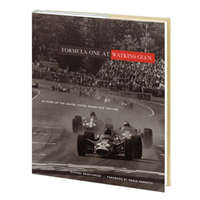
Formula One at Watkins Glen: 20 Years Of The United States Grand Prix, 1961-1980, by Michael Argetsinger (David Bull Publishing, ISBN: 978-1-935007-14-2, $49.95)
On 8 October 1961, the United States Grand Prix was held for the first time at Watkins Glen, the culmination of an effort that began thirteen years earlier, on 2 October 1948, with the running of the first “Watkins Glen Grand Prix.” That a small village in New York State, nestled at the southern end of Seneca Lake, would become the Mecca for postwar American road racing is no longer quite as familiar a story as it once may have been in years past. Today, Watkins Glen is one of the only two road races on the schedule for the NASCAR Sprint Cup Championship, which often means few realize not only just how did Watkins Glen manage this feat, but that its history contains two decades of hosting the United States Grand Prix.
If the Leerhsen and Cannell books were, not to mince words, disappointments, the same cannot be said for Mike Argetsinger’s new book. The noted biographer of Walt Hansgen and Mark Donohue, when Argetsinger turned his attention to his next project, that the fiftieth anniversary of the first United States Grand Prix held at Watkins Glen was approaching made that choice very easy. While the choice may have been relatively easy, the task itself was anything but easy. Argetsinger reviewed an astounding number of photographs, over 47,000, to select those that made it into the book.
The United States Grand Prix did not simply magically appear at Watkins Glen. Argetsinger takes the time to highlight the three Formula Libre events held at Watkins Glen from 1958 to 1960, whose success led to the track becoming the venue for the United States Grand Prix after Alec Ulmann allowed his option for the 1961 event to lapse. Few now remember that the race was offered to the Watkins Glen Grand Prix Corporation by the Automobile Competition Committee of the United States only after the 15 August date had passed and Ulmann made no offer to extend the option. That the race date was 8 October, already on the international calendar for the running of an Intercontinental Formula event, meant that there was scarcely six weeks from the time the sanction was extended to the running of the USGP. Needless to say, despite the short timetable, it all happened as planned.
If the pictures alone are well worth the price of the book – and they most certainly are, then there is a wonderful bonus in the introduction and the brief text that accompanies each chapter. Argetsinger provides not only a brief sketch of each event, providing some seasonal context, but also provides a running commentary regarding events going on in the background of the organization running the event. Argetsinger does not spare us or sugarcoat the fall and eventual demise of the Watkins Glen Grand Prix Corporation, and the end of the USGP at Watkins Glen.
In most books of this sort, the captions almost always seem as almost an afterthought and they usually read that way. This is certainly not the case the captions that are found in Formula One at Watkins Glen. If the selection of the photographs used is superb, then the captions that accompany them are equal to the challenge. This is an excellent book, one that meets the challenge that many similar books fail to even come close to accomplishing: a picture book that is more than just a vehicle for lots of nice pictures – eye candy, but that provides substance in the form of concise, well-written text with informative and erudite captions to those photographs. Of course, this is to be expected given Argetsinger’s earlier efforts.
Formula One at Watkins Glen is a special book because all profits generated by the book are going to the sustainment of the International Motor Racing Research Center located in Watkins Glen. The publisher, David Bull, is producing the book at cost and Argetsinger receives no fee for writing the book. Even more extraordinary is that none of the photographers whose work appears in the book are compensated, all waiving their usual fees. The purchase of the book ensures that the IMRRC can continue its work well into the future, providing automotive historians with a place to meet, the use the resources of the Center, and allowing the next generation of automotive historians to develop and prosper.
American Race Tracks
I have been fascinated by race tracks, both as the hosts for events and as venues and locates on their own. Here are simply a few items that caught my interest in recent days and would like to pass along to others for their perusal and possible edification.
Tacoma
The Tacoma Speedway that is best remembered is a planked board track that was not quite an “oval” but more a planked, square-like semi-road course. Often overlooked is that prior to its construction there were two earlier versions of the speedway, both considered as road courses.
The first version of the Tacoma Speedway was five mile road course used in 1912.
 19
19
In 1913, the course was reduced to its original five miles to three and a half miles in length, although retaining the basic configuration of the course used the previous year. This was done by moving one leg of the course to the other side of the Lake View community.
 20
20
In 1915, the speedway was shortened once again and rebuilt as a hybrid planked-board track: although planked boards were laid down as the basis for the track, unlike the other board tracks being built, where the banking was being set at ever steeper angles, there was relatively little at the Tacoma track.
 21
21
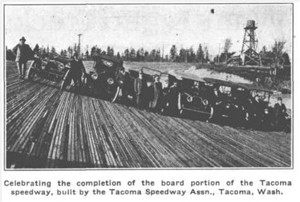 22
22
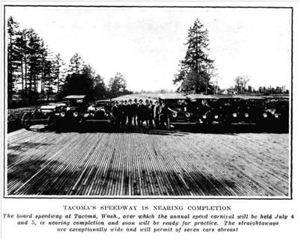 23
23
 24
24
Sioux City Speedway
The Sioux City track was a classic “paperclip” track, being built as a dirt track in 1911 just as the planked board tracks were beginning to appear on the scene in California and road racing was hitting its stride.
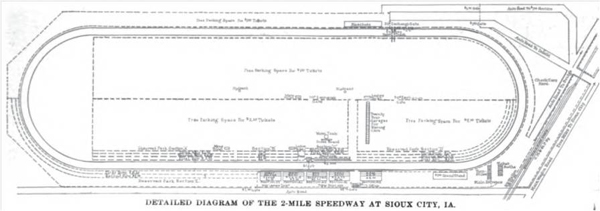 25
25
Omaha Speedway
The interesting thing about the Omaha Speedway was that it was actually located in Iowa and not Nebraska. Even for a board track its lifespan was short, scarcely three seasons as a first rank venue, 1915 thru 1917.
 26
26
The photograph showing a section of the Omaha track is one of the better representations of what the track surface of one these tracks actually looked like, showing both how the planks were laid and giving an idea as to the problems such construction entailed.
 27
27
Speedway Park
 28
28
 29
29
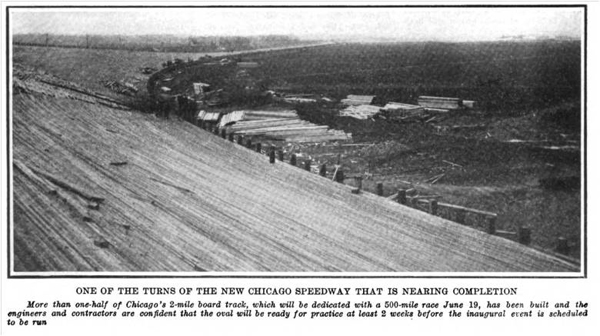 30
30
Often erroneously referred to as “Chicago Speedway,” Speedway Park was originally envisioned as a sporting complex, complete with polo field, golf course, and other amenities. It was one of the planked board tracks that sprang up during the 1915 season, altering the direction of automobile racing in the United States for about a decade. The speedway was located in the suburb of Maywood, which bordered another community, Burnside. The speedway only had four seasons of racing, 1915 thru 1918, before suffering the fate that seemed to be that of the board tracks in general – deterioration and then being dismantled.
Sheepshead Bay Speedway
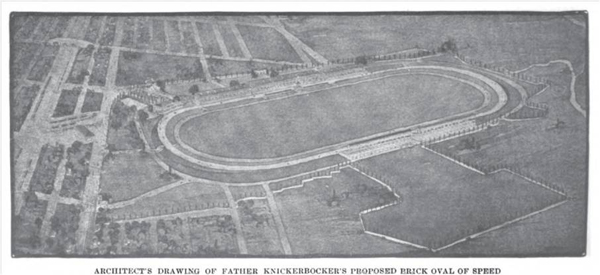 31
31
The Coney Island Jockey Club built a track in the Sheepshead Bay neighborhood of Brooklyn, but the outlawing of betting on horse racing and trotting events left the club with a track and not much in the way of income after the law took effect. The site was bought by a group of investors with the intent of building a race track constructed of bricks, much like that of the Indianapolis Motor Speedway. However, it was then decided to switch to wood, which would allow the track to be finished by the end of the 1915 season. It was demolished in 1920 and the site used for a housing development.
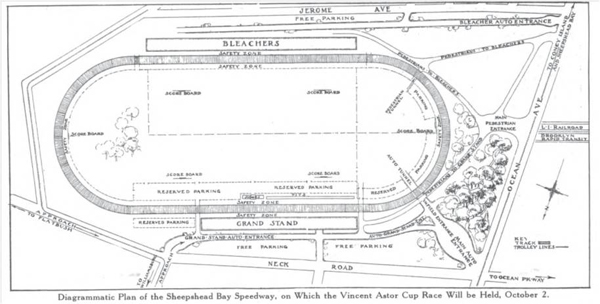 32
32
Twin City Speedway
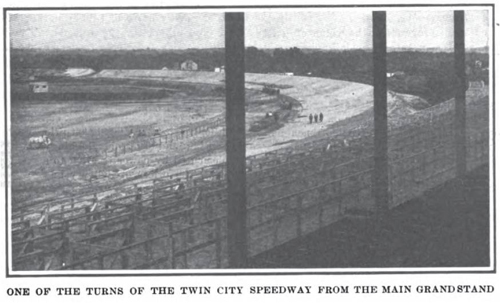 33
33
 34
34
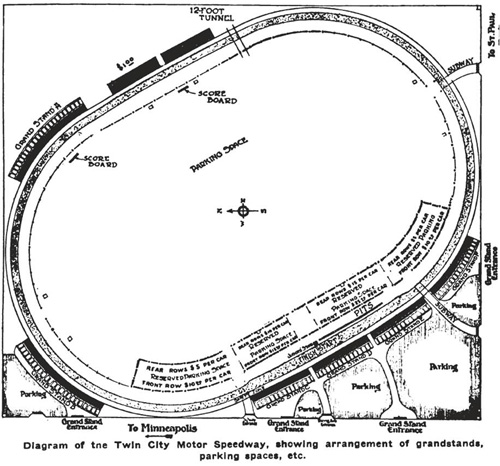 35
35
Unlike most of the other speedways which popped up during the 1915 season, the Twin City Speedway was constructed of concrete and not wood, only the Narragansett Speedway in Rhode Island using this type of material in its reconstruction the next year, being converted from a dirt track to a banked speedway.
Notes
- A.J.P. Taylor, "What Else, Indeed?", The New York Review of Books, 5 August 1965 (Volume 5 No. 1).
- Page 259.
- This is from a remark by Leerhsen in an email exchange with another sports journalist who was questioning Leerhsen regarding his thesis on finishing order of the race.
- “New Book About the First Indy 500,” The Nostalgia Forum, The Autosport Bulletin Board
- “New Book About the First Indy 500,” Motorsport History forum, Motorsport Forums
- Charles Leerhsen posting as “BloodandSmoke” on 29 April 2011 on TNF, Autosport Bulletin Board
- 23 April 2011, Ibid.
- Charles Leerhsen posting as “BloodandSmoke” on 26 April 2011 on Motorsport History forum, Motors-port Forums.
- Don Capps, posted 4 May 2011 Motorsport History forum, Motorsport Forums.
- Russ Catlin, "Who Really Won The First Indy 500?" Automobile Quarterly, Vol. 8, No. 4 (1969), pp. 382-385.
- Russell Jaslow, “Who Really Won the First Indy 500?”, The North American Motorsports Journal
- “…if it’s not true, it’s still a good story.”
- “The Limit is a great read, has received almost uniformly positive reviews in the popular press and will prove satisfying to the vast majority of Veloce Today readers. However, a few cognoscenti will know the score well enough to hear the sour notes.” Michael T. Lynch, “Michael T. Lynch on ‘The Limit’,” 30 November 2011, Veloce Today
- Page 283.
- Wallace Wyss, “Interview with Michael Cannell, Author of ‘The Limit’,” 23 November 2011, , Veloce Today
- Jim Murray, “The 500: ‘Gentlemen, Start Your Coffins!’,” Los Angeles Times, 29 May 1966, n.p.
- Review by Michael T. Lynch
- “The word ‘creative’ refers simply to the use of literary craft in presenting nonfiction—that is, factually accurate prose about real people and events—in a compelling, vivid manner. To put it another way, creative nonfiction writers do not make things up; they make ideas and information that already exist more interesting and, often, more accessible.” Lee Gutkind, “What Is Creative Nonfiction?”, Creative Nonfiction
- F.K. Haskell, “Tetzlaff Adds to His Speed Laurels,” Motor Age, 11 July 1912 Volume XXII No. 2, p. 7.
- F. Kirby Haskell, “Stutz Sweeps the Card at Tacoma’s Road Race Meet,” Motor Age, 19 July 1913, p. 8.
- “Tacoma Trying New Idea in Speedway Construction,” Motor Age, 8 April 1915, p. 14.
- The Automobile, 29 April 1915, p. 781.
- Motor Age, 29 April 1915, p. 11.
- Carol Sims, “Tacoma: The Mysterious Two-Miler,” Dick Wallen, ed., Board Track: Guts, Gold & Glory, Kutztown, Pennsylvania: Kutztown Publishing, p. 63.
- “Best Roads to Sioux City and Omaha,” Motor Age, 24 June 1915, p. 31.
- Ibid.
- Best Roads to Sioux City and Omaha,” Motor Age, 24 June 1915, p. 29.
- “A 2-Mile Board Speedway for Chicago,” The Automobile, 17 December 1914, p. 1137.
- “Work Begins on Chicago Speedway,” The Automobile, 29 April 1915, p. 780.
- “Chicago Automobile Club Will Conduct First Speedway Race,” Motor Age, 20 May 1915, p. 23.
- “Big Financial Interest Back New York Speedway,” Motor Age, 15 April 1915, p. 14.
- “Trade Happenings,” The Horseless Age, 1 September 1915, p. 243.
- “Twin Cities Ready to Dedicate New Concrete Speedway,” Motor Age, 2 September 1915, p 14.
- Ibid.
- “America’s First Concrete Speedway,” The Automobile, 2 September 1915, p. 434.

